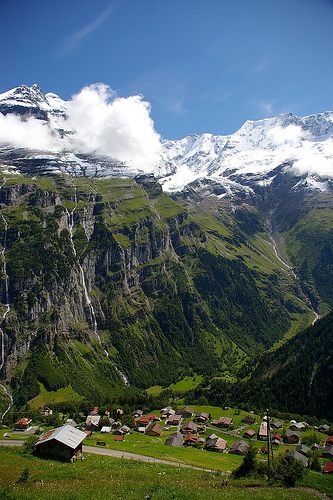

Location: Canton of Bern Map
Gimmelwald is a quaint, car-free mountain village nestled in the Bernese Oberland region of Switzerland, renowned for its unspoiled alpine charm and breathtaking views of the Lauterbrunnen Valley. Perched at an elevation of 1,367 meters (4,485 feet) on a steep cliffside, it serves as a peaceful retreat amid the dramatic Swiss Alps, with a population of around 130 inhabitants who maintain a traditional farming lifestyle. Unlike nearby tourist hotspots such as Mürren or Grindelwald, Gimmelwald remains largely untouched by mass tourism, preserving its authentic character as a Walser settlement with flower-adorned chalets, roaming cows, and a sense of timeless serenity. Situated in the municipality of Lauterbrunnen, Canton of Bern, at coordinates approximately 46°32′N 7°52′E, the village is accessible only by cable car or foot, emphasizing its isolation and appeal as a hidden gem for hikers and nature lovers. Often highlighted in travel guides for its "Swiss Alps in your lap" vibe, Gimmelwald attracts visitors seeking an off-the-beaten-path experience, blending rustic simplicity with stunning panoramic vistas of snow-capped peaks like the Jungfrau.
Gimmelwald's history dates back to the Middle Ages, with its first
documented mention in a 1346 bill of sale, marking it as an Alemannic
linear village and a Walser settlement—a group of Germanic-speaking
migrants from the Valais region who colonized high alpine areas in the
13th-14th centuries. The Walsers, known for their hardy farming and
herding practices, established Gimmelwald as a remote outpost in the
challenging terrain of the Bernese Oberland, adapting to the steep
slopes and harsh winters. During the medieval period, the village was
one of Switzerland's poorest, relying on subsistence agriculture, dairy
farming, and transhumance (seasonal livestock migration), with residents
living in close harmony with nature and their animals.
In the modern
era, Gimmelwald's development was influenced by the rise of alpine
tourism in the 19th century, though it remained overshadowed by more
accessible neighbors. The arrival of the cable car from Stechelberg in
the mid-20th century improved access, but the village actively resisted
commercialization, preserving its traditional character through
community efforts and zoning laws that limit new construction. Today, it
exemplifies sustainable rural living, with many families continuing
multi-generational farming traditions while embracing eco-tourism. The
village's name, derived from Old High German roots meaning "valley of
the twins" or similar, reflects its linguistic heritage from the Walser
dialect.
Gimmelwald is dramatically positioned on a narrow ledge along the western cliffs of the Lauterbrunnen Valley, part of the UNESCO-listed Swiss Alps Jungfrau-Aletsch region. The village overlooks a deep glacial valley carved by ancient ice flows, with sheer drops of up to 1,000 meters to the valley floor below, offering unobstructed views of the Bernese Alps, including the Eiger, Mönch, and Jungfrau peaks. Surrounded by lush meadows, dense forests, and cascading waterfalls, the terrain is characterized by steep slopes ideal for hiking but challenging for traditional farming, which focuses on hay production and dairy. The climate is alpine, with mild summers (average highs of 15-20°C) perfect for wildflowers and cooler winters bringing heavy snowfall, transforming the area into a ski destination. Geologically, the region features limestone karst formations and glacial moraines, contributing to the valley's U-shaped profile and the village's precarious yet scenic perch. Its location in the Bernese Oberland places it within a network of alpine trails, making it a gateway to the Jungfrau Region's natural wonders.
Gimmelwald's architecture embodies traditional Swiss alpine design, with clustered wooden chalets built from local timber and stone, featuring steeply pitched roofs to shed heavy snow and flower-boxed windows adding vibrant color. The village layout is linear, following a single winding path that serves as the main "street," lined with about 13 farms and a handful of guesthouses, barns, and small shops. Structures date primarily from the 18th-19th centuries, with some older elements reflecting Walser influences, such as elevated granaries on stilts to protect against rodents. The absence of cars preserves the pedestrian-friendly, cobblestone-like paths, while cowbells and roaming livestock enhance the pastoral ambiance. Key buildings include the historic schoolhouse (now a community center) and simple Protestant chapel, underscoring the village's modest, functional aesthetic.
Gimmelwald's attractions revolve around its natural surroundings and slow-paced lifestyle, making it ideal for immersive alpine experiences. The village serves as a starting point for numerous hiking trails, including the North Face Trail to Mürren or paths to the Sefinen Valley, offering views of glaciers and wildflowers. Visitors can observe traditional cheese-making at local farms or join cow parades during the seasonal alp descent (Almabtrieb) in autumn. The cable car ride from Stechelberg provides aerial perspectives of the valley's 72 waterfalls, while the village's guesthouses, like the historic Hotel Mittaghorn, offer cozy stays with home-cooked meals. Winter activities include snowshoeing and cross-country skiing, with the area transforming into a quiet snowy paradise. Cultural features include interactions with locals, who maintain Swiss traditions like yodeling and alpine farming, providing an authentic glimpse into rural life.
Gimmelwald is accessible year-round via cable car from Stechelberg (about 5 minutes, 10-15 CHF one-way), with connections from Lauterbrunnen by bus or train. No entry fees apply, but accommodations range from budget hostels (50-100 CHF/night) to family-run guesthouses; book in advance for peak summer (June-August) or winter seasons. The village has limited facilities—a small grocery, cheese shop, and a few eateries—so stock up in Mürren or Lauterbrunnen. Tips: Wear sturdy shoes for hikes; respect private farms by sticking to paths; visit early morning for fewer crowds and optimal light on the peaks. The Swiss Travel Pass covers transport; for sustainability, avoid single-use plastics in this eco-conscious area. Official resources: www.muerren.swiss or local tourism apps for trail maps.